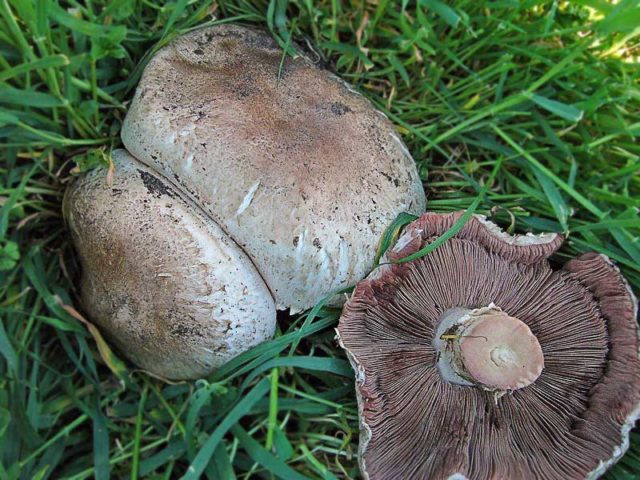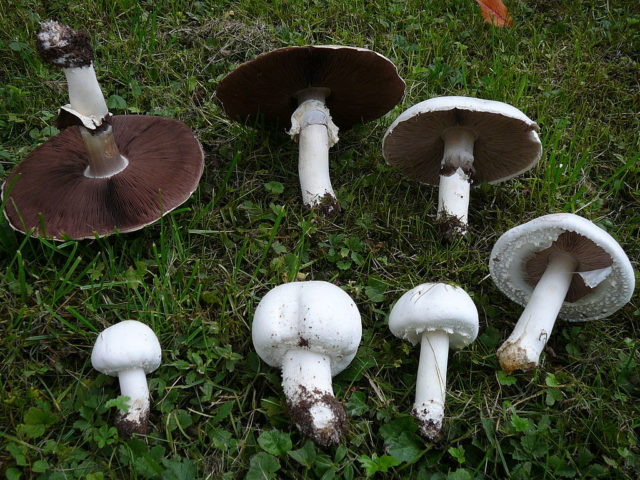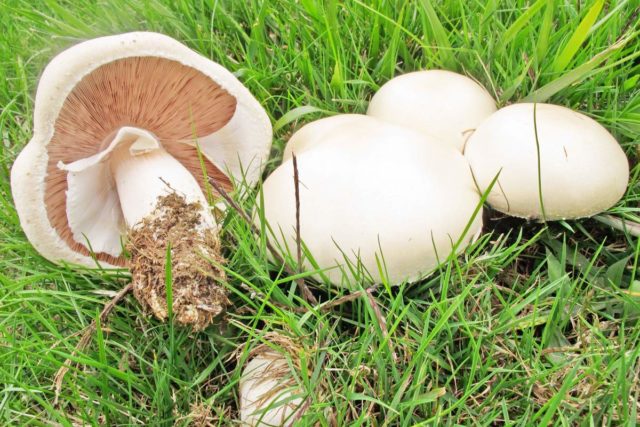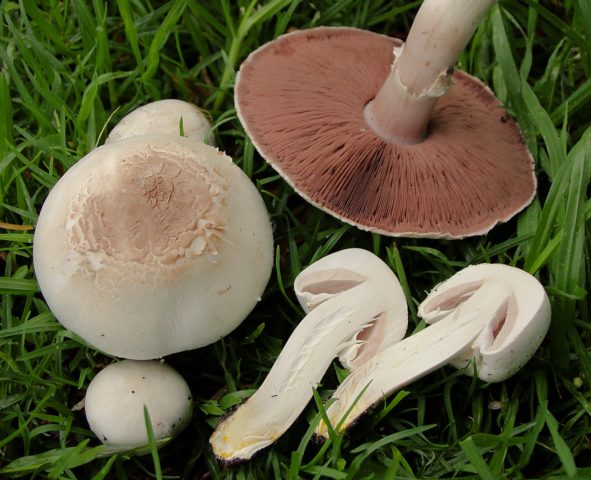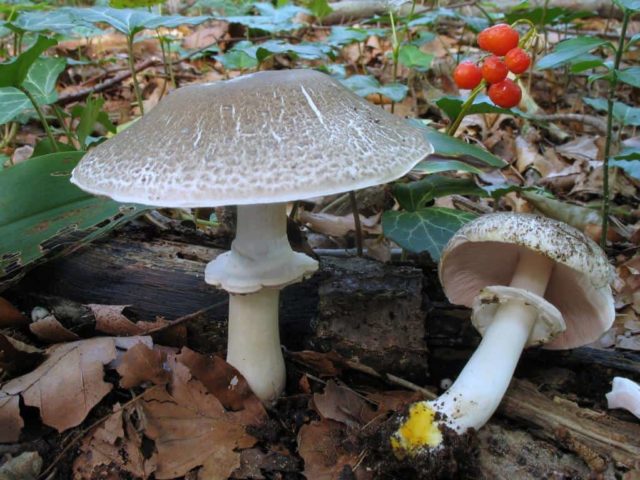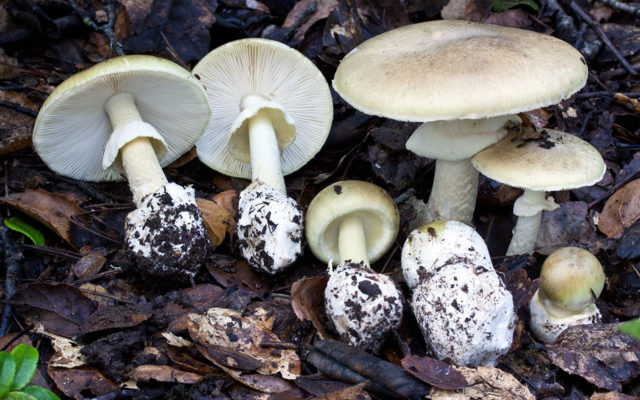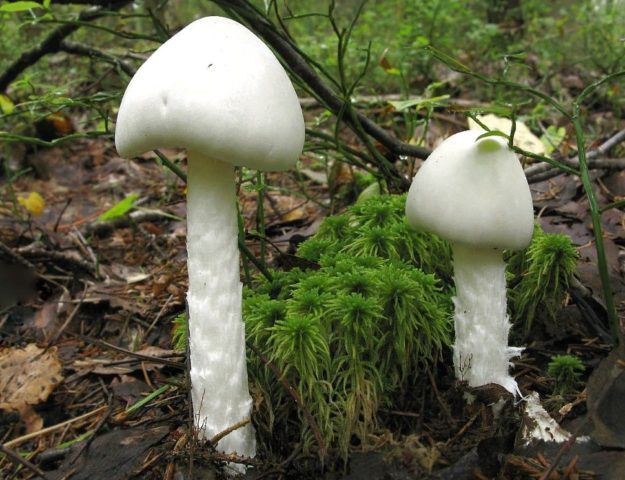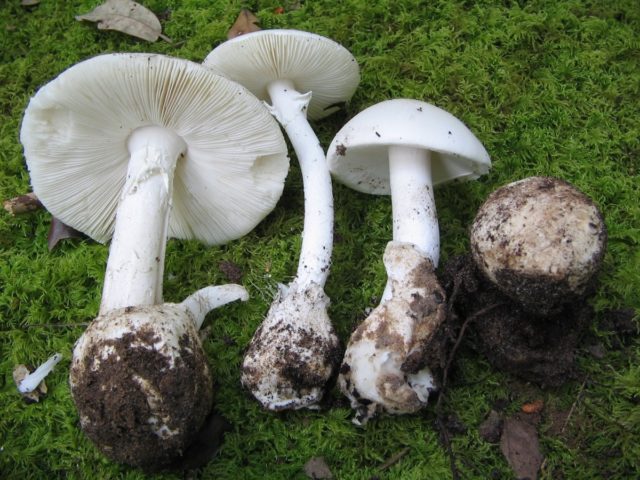Content
Champignons are probably the most popular mushrooms used in the cuisines of many countries. They are grown artificially and harvested from the wild. However, along with edible mushrooms during a "quiet hunt", a dangerous double of the champignon can also be caught - the so-called yellow-skinned champignon, which is not only inedible, but also toxic. And this is far from the only dangerous mushroom that looks like real champignons.
Types of edible champignons
In total, about 200 species of various mushrooms are distinguished in the scientific classification, of which a relatively small part is unsuitable for human consumption. There are very few poisonous among them. Such favorable conditions, combined with the ease of artificial cultivation, are the reason that at present more than 1/3 of all artificially grown mushrooms in the world are champignons. In Russia this figure is much higher - over 70%. Below are photos and descriptions of some false and real mushrooms.

Champignons are the most commonly used mushrooms in cooking
Depending on the growing conditions, all mushrooms are divided into 5 main groups:
- Forest.
- Growing in open spaces.
- Growing only in the grass.
- Growing in grass and forests.
- Deserted.
The most famous edible species are as follows.
- Champignon is double-peeled. This is an edible mushroom I, of the highest category, it is also called cultivated, cultivated or garden champignon. It grows from late spring to autumn on cultivated, organic-rich soils, found in gardens and pastures. The mushroom cap resembles a hemisphere with an inward-curled edge. Its diameter is usually from 5 to 15 cm, although there are also larger specimens. The color is light brown, more intense in the center, with noticeable radial fibers or scales. Numerous thin plates are located on the back of the cap. Their color changes depending on the age of the fungus, from pinkish to brown, and later dark brown with a purple tint. The stem of the mushroom is dense, solid, 3-8 cm long, cylindrical, smooth, usually colored the same color as the cap. The pulp of the mushroom turns slightly pink on the cut. She has a pleasant mushroom aroma and good taste.
- Field champignon (sheep, ordinary). Found throughout Russia. It grows from the end of May until the onset of cold weather in the grass in open spaces, in meadows, in gardens and parks, found on forest edges and clearings. The young field champignon has a hemispherical cap, which, as the mushroom grows, becomes first umbellate and then almost flat. Its upper part is white, shiny, velvety to the touch. Below there are numerous plates, in young mushrooms, covered with a blanket. Their color changes with the age of the fungus, in young specimens they are grayish, then turn pink, and then turn brown with a chocolate tint. The leg is white, cylindrical, strong, the ring is two-layer, hanging. The pulp is white, turns yellow at the break. Experienced mushroom pickers can easily recognize this champignon by the characteristic smell of anise.
Important! Many experienced mushroom pickers consider this particular type of champignon to be the most delicious and valuable. - Common champignon (real, meadow, pechin). It can be found from late May to mid-autumn in open grassy places, in meadows, in the steppe, on cultivated lands, near roads, farms, and residential buildings. At a young age, this type of champignon has a spherical and then a hemispherical cap, which eventually takes on a prostrate shape. It is light brown, dry, pleasant to the touch. On the reverse side there are numerous thin plates that change color from white to pinkish as they grow, later they darken more and more and become chocolate brown, and in adulthood acquire a dark brown color with a purple tint. The stem of the mushroom is straight, cylindrical, white, dense. A wide thin ring is usually located in its middle part. The pulp at a cut or break turns pink at first, and then turns red. Common champignon is widely used in cooking, it can be used in any form. In terms of the content of nutrients, it is comparable to the porcini mushroom.
A short video on how the common champignon grows in the wild:
- Large-spore champignon. This species is widespread in Central, Western and Southern Europe, in Russia it is found only in some southern regions. It is distinguished by its large size, for example, the cap can reach 0.5 m in diameter. It is round-convex, fibrous, white, with small fringes at the edges, and becomes covered with scales with age. The plates located on the back of the cap are small, thin, light pink in a young mushroom, brown in an old one. The leg is white, rather short and thick, massive. The ring is single, with well-visible scales below. The pulp is dense, white, with mechanical damage it slowly turns red. Young large-spore champignon has a pronounced almond aroma, however, with age, the smell begins to resemble ammonia. Has excellent taste.
In addition to the listed types of champignons, there are many others that have a lower nutritional value, but are edible.
What mushrooms look like champignons
Champignons are lamellar mushrooms. At a young age, many species from this class of them have a hemispherical or spherical shape, which is always fraught with confusion in their visual identification. Their false counterparts - inedible champignons - have the greatest similarity with edible mushrooms.
In addition to related species, other mushrooms also have similarities with champignons, especially at the initial stage of development. It is especially dangerous that some of the false counterparts are deadly poisonous.
Are there false champignons
The term "false" is usually understood as a poisonous or inedible mushroom, which can be mistaken for the species in question due to external similarity. Edible champignons also have such counterparts.
What false champignons look like
Some inedible siblings from the Agaric family, that is, their closest "relatives", have the greatest visual similarity with edible champignons. Here is a photo and description of some false mushrooms:
- Red champignon (yellow-skinned peppermaker). This false counterpart of the edible champignon at a young age has a semicircular, and in a later period of development, a bell-shaped cap with scales up to 15 cm in diameter. The color of its upper part is white with a characteristic uneven coffee-brown spot in the center. On the reverse side there are small, even plates, which change color from white to pink, and then to brown with age. The leg of this twin is white, hollow, with a tuber at the base. The ring is wide, white, two-layer. The flesh is brownish in color, with mechanical damage it turns yellow. It emits a characteristic "chemical" smell of phenol, which intensifies when heated. The fungus is found in many regions and can be found in mixed forests as well as in gardens and parks.It grows from the second half of summer to mid-autumn. It is impossible to eat this false double; if it enters the body, it causes poisoning and intestinal disorders. Despite this, the mushroom is considered medicinal and is used in folk medicine.
- Motley champignon (Meller, scaly). In young mushrooms, the cap is rounded, in adults it becomes flat-spread. From above, it looks spotty due to the large number of lagging scales of gray or ash brown color. Their greatest density is in the center, on the periphery of the cap there are few scales, so the color there is almost white. On the back of the cap of this false double there are numerous even thin plates, in a young mushroom they are pale pink, darken as they grow and acquire a chocolate color. The stem is cylindrical, dense, white; as the mushroom grows, it becomes first yellow and then brown. The ring is dense, pronounced. The flesh at the break is white, quickly turns brown. Has an unpleasant odor. This false twin is widespread in the southern regions, grows in the steppes and forest-steppes, and sometimes comes across in parks. The toxicity of the variegated champignon is assessed differently in different sources, in some it is indicated as poisonous, in others this feature is not noted. With a high degree of probability, this indicator depends on the place where the mushrooms grow and the individual tolerance of the human body that has eaten them.
- Californian champignon. At the early stage of growth, the cap of this false twin is rounded, later spread out, dry, light brown with a metallic sheen, darker in the center and light at the periphery. The plates on the reverse side are white, even, with age they acquire a pinkish tint, and then become chocolate brown. The stem is cylindrical, often curved, with a ring. At the cut site, the pulp slowly darkens. This false champignon emits an unpleasant smell of phenol, is poisonous and is not eaten.
- The champignon is flat-lipped. This false double is often found in deciduous and mixed forests of the temperate zone, it can often be seen next to the veins of buildings. The cap is ovoid at a young age; in an adult fungus, it gradually straightens out and becomes almost flat, with a small tubercle in the center. The upper part is covered with numerous gray scales, more densely in the center and less intense in the periphery. The plates located on the back of the cap are slightly pinkish at a young age; as the fungus ages, they darken and become dark brown, almost black. The stem is white, cylindrical, with a pronounced ring in the middle part. The pulp is white, if damaged it turns yellow and then turns brown. It emits an unpleasant "chemical" smell of carbolic acid. According to some estimates, flathead mushroom is conditionally edible, according to others, this false twin is considered weakly poisonous, causing intestinal disorders.
Photos and descriptions of other false mushrooms can be found in specialized literature.
How to distinguish champignon from false champignon
It is possible to determine whether the champignon is false or not by external signs, as well as by their smell. The real ones have a pleasant mushroom smell with hints of almond or anise. False champignons have a persistent unpleasant odor of carbolic acid or phenol, which intensifies during heat treatment of the mushroom. In case of mechanical damage, the pulp of false twins turns yellow and then turns brown, while real champignons turn pink or slowly turn red when cut.
Poisonous mushrooms similar to champignons
Edible champignons can be confused not only with false counterparts from their family, but also with some really deadly poisonous mushrooms, especially at a young age. Here are the most dangerous ones.
Death cap. At a young age, it can be confused with champignon, this is the most dangerous of its twin mushrooms.
The differences between the pale toadstool are as follows:
- There is a tuberous thickening at the bottom of the leg.
- Plates at any age remain completely white.
- Absent.
Amanita is smelly. In appearance, this deadly mushroom is very similar to champignon, however, it also has its own distinctive features.
Here are the main differences between the stinky fly agaric.
- Bell-shaped sticky mucous cap.
- Scaly leg.
- The presence of a volva (tuber).
- White regardless of the age of the plate.
- Unpleasant chlorine smell.
Amanita is white. This mushroom is also deadly poisonous.
The differences between white fly agaric and champignon are as follows.
- The mushroom is completely white.
- The plates are always white and do not change color with age.
- There is a pronounced Volvo.
- Produces an unpleasant odor.
Poisoning symptoms, first aid
Cases of poisoning by poisonous mushrooms, mistaken for champignons, are recorded annually. Unfortunately, most of these cases end in tragedy. In this regard, the most dangerous is the erroneous eating of the pale toadstool - one of the poisonous counterparts of the champignon. Unlike other similar in appearance poisonous fly agarics, the pale grebe has no smell, so it is almost impossible to recognize it by this sign.
The clinical picture of toadstool poisoning manifests itself with a long delay, which makes it difficult to diagnose and start treatment in a timely manner. The first symptoms may appear only after a day, and in some cases even more. Here are the main signs of pale toadstool poisoning.
- Colic, cramps and stomach cramps.
- Nausea, constant vomiting.
- Diarrhea.
- Deterioration of the general condition, weakness.
- Arrhythmia.
- Constant thirst.
- Consciousness disturbances.
As a rule, on the 3rd day after the poisoning, there is an improvement in well-being, but this is only an appearance that the body has coped with the poisoning. The destructive effect of toxins continues at this time. After 2-4 days, the function of the liver and kidneys is impaired, jaundice develops, and the structure of the blood changes. In most cases, death from acute heart, renal or hepatic failure follows on days 10-12.
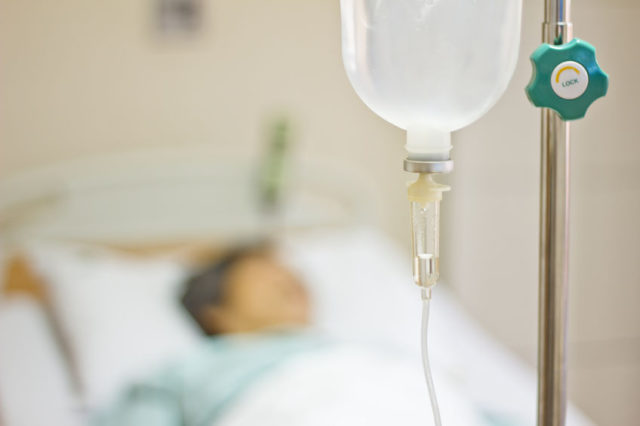
In case of poisoning with poisonous mushrooms, urgent hospitalization is required
In case of pale toadstool poisoning, it is very important to start treatment as early as possible. This is not a guarantee of recovery, but it does give a chance. If you do not take urgent measures, 90% of cases of poisoning end in the death of the victim. Therefore, if you suspect poisoning, you need to take the poisoned person to the nearest hospital as soon as possible or call a doctor at home. Before his arrival, you should flush the victim's stomach, forcing him to drink a large amount of slightly salted water, and then induce vomiting. And you should also give him activated charcoal (1 tablet for every 10 kg of weight) or another enterosorbent.
Conclusion
Any mushroom picker can meet a dangerous double of the champignon. However, any unpleasant consequences from this meeting can be avoided if you follow the rule: “I don’t know - I don’t take”. If there is no clear confidence in the edibility of the mushroom, you should not take it.
